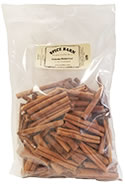Cinnamon Sticks 2 3/4"
- Product
- Cinnamon Information


| Cinnamon Sticks 2 3/4 Inch 1 Pound Pouch $15.99 |
Discounts begin at 5 Pounds. See below.
Discounts will be reflected in the cart.
| Bulk Quantity | |
| 5-14 Pounds | 10% off Regular Price |
| 15-24 Pounds | 15% off the Regular Price |
| 25+ Pounds | 20% off the Regular Price |
Description: The curled bark of the tree. The bark, reddish brown in color, is rolled into quills, then cut to 2 3/4 inch lengths. Estimate: 100+ sticks per pound...this is not an exact count.
Usage: Cinnamon sticks spice ragout, rice, mulled wine, and punch.. Add to hot buttered rum, cider or tea for great sipping!
Recipes for Cinnamon Sticks
Ingedients: Cinnamon.
Storage:Store in a cool dry place, away from heat, light, and humidity.
Other Available Sizes: Cinnamon Sticks 4-inch Cinnamon Sticks 6-inch
Cinnamon is one of the oldest spices. It has been prized by man since the beginning of civilization. Cinnamon was one of the major factors in the exploration of the new world, playing a decisive role in the discovery of America. Cinnamon still ranks as one of the most popular flavors and of utmost importance for all bakers!
Cinnamon actually comes from the bark of trees in the evergreen family. There are several varieties of trees from which we derive cinnamon which are referred to as the "cinnamomum" family. Most of the cinnamon comes from trees of the "cinnamomum cassia" family. This is why you may hear the spice referred to as "cassia". In the industry, this term is used to distinguish between the cassia type of cinnamon and the Ceylon type of cinnamon. Cinnamon is graded on its content of essential oil. The higher the oil content, the more aroma and flavor. Therefore, cassia types of cinnamon , which average higher oil content than the Ceylon types, are rated superior by the cinnamon loving population.
The cassia group is native to China, Indo-China, and Indonesia. Unquestionably, the cinnamon best suited to American bakers comes from the cassia type of cinnamon. Indonesia supplies two types: Korintje and Vera. Vietnam is also a producing area, supplying what is known as Vietnamese or Saigon cinnamon. China is also supplying cinnamon since the U.S. has resumed trade with that country. The Indonesian cinnamons come from the inland mountains on the island of Sumatra. The highest concentration of oil in Korintje and Vera are found in the thicker bark on the lower parts of the trees. Korintje characteristically has a slightly more intensive color and flavor than the Vera and is rated the better type. In general, Korintje is deep reddish brown and has a sharp cinnamon flavor; the Vera is lighter in color.
Ceylon Cinnamon comes from the island of Ceylon (Sri Lanka). This is regarded as "real cinnamon". This product is mainly used in Mexico, Central and South America. Only a negligible amount is used in the U.S. and most of that is sold in stick form. Most people prefer the taste of Cassia.
Saigon Cinnamon has traditionally been considered the finest quality cinnamon due to the fact that the oil content runs higher on average than the other types. Saigon has a distinctly sweet flavor as compared to the Indonesian types. The color is darker than the Indonesian as well.
Chinese cinnamon is derived from the barks of trees from the south eastern part of China. It has similar characteristics to those of Saigon cinnamon, but it is lower in essential oil and therefore not as strongly flavored. The color tends to be more a true brown rather than the reddish brown. The two varieties are Sikiang and Tunghing.
There are also several types of cinnamon on the market available at a considerable discount which are termed "Ceylon-type" and "Cassia-type". These generally are lighter in color and have a more neutral flavor.
Cinnamon should be stored in a dry, cool place, away from heat and light. Excessive heat will dissipate the essential oils and high humidity will tend to "cake" it. Also, close your spice container immediately, exposure to air will also cause some loss of flavor and aroma.




